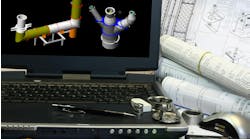BY WILLIAM AND PATTI FELDMAN
COMPUTER AUTHORITIES
SOMETIMES IT SEEMS that computer technology is getting integrated into the ways of the mechanical contracting business that soon just about the only part of a design/build project it won't be able to handle is the handshake that seals a deal.
Right-Suite Residential (Wrightsoft, www.wrightsoft.com, 800/225-8697), a modular solution first introduced as an automated way to calculate Air Conditioning Contractors of America's Manual J loads and Manual D duct sizing and now in its 6th edition, automates the design and calculation processes for residential and small business projects. But now the latest edition, through the newest module, Right-Sales, automates the presentation and proposal process for laptop-toting contractor sales personnel making in-home sales calls.
All 10 modules center around an object-oriented drag-and-drop drawing module, which supports importing and reading of AutoCAD files without requiring AutoCAD and features 17 HVAC symbols representing factors that can affect heating requirements. The modules, which include the ability to easily draw and incorporate radiant heating and snow-melt systems, are tightly integrated. Changes in the drawing or any aspect of the developing proposal are reflected throughout the system.
The new Right-Sales module enables HVAC contractors who are not as savvy in sales and marketing as they are in technical expertise to prepare and present organized, professional-looking proposals right from their laptops. This could be a value-added differentiating selling tool, particularly in the residential retrofit market, because it personalizes the presentation and provides an easy way to show upgrade possibilities.
The module includes customer-preference questionnaires that involve the homeowners in shaping the scope of the project from the get-go so the designed system meets their needs and matches their budget.
Using customizable templates, the user can easily compose logically sequenced presentations that may include drawings clarifying various loops and zones, energy analyses, Power-Point slides, load calculations and good-better-best equipment selection, backed with product cut sheets, digitized catalog pages, and even company and manufacturer videos.
Another component of the sales module supports easy evaluation of any salesperson within any group or against all other sales personnel, and company-wide sales against various parameters (e.g., date range or territory). Users can view statistics in numerical or graphical format.
Right-Sales links with an Internetenabled catalog module that keeps atop the latest pricing updates from participating dealers, distributors and OEMs, for inclusion in each sales proposal.
Software boosts efficiency
Wireless PDAs running field management software that allows access to operating solutions back in the office enable technicians to pull in new and historical information about customers, calculate timesheets and transmit updated information back to the database.
Pervidi (Techs4Biz, www.techs4biz. com, 800/361-8725), a service and maintenance management system using a combination of software, handheld PDAs and Web portals, allows contractors great latitude in how they can connect out of the office. Field service personnel can utilize almost any type of wireless handheld device to run the software application, which allows management to schedule work on an office computer and send along details of the work order to the handhelds and receive updated data at the end of the day.
Choices of receiving devices include several types of PDAs and Smart-Phones: Palm devices, Pocket PC devices and Blackberries, leaving no one out in the cold.
Suitable for both service providers and facilities managers, Pervidi utilizes wireless wide area networks to connect the field technician's PDA with the office system.
"This ensures that your coverage is based on your carrier coverage (which is continuously expanding), and you do not have to pay for expensive custom infrastructure costs," notes Eitan Shibi, president of Techs4Biz.
Using wireless PDAs as an extension of a field service management system enables technicians to complete more calls per day because there is less downtime between calls, and it decreases overhead and operating costs by eliminating paperwork and the errors and delays that can occur in a paper-based environment. Invoicing is processed as soon as the job is completed, possibly substantially reducing lag in accounts receivable. The solution might also result in need for fewer dispatchers.
Before you take your software out into the field for wireless communication, Shibi suggests doing preliminary groundwork to ensure a smooth transition. Check your wireless phone provider to make sure it provides full coverage in your service area. And make sure you have a good Internet service provider. Wireless dispatching requires reliable broadband Internet access.
"If your Internet provider's service goes down, so does your dispatch system," Shibi notes.
The solution also supports signature capture and mobile printing, which enable customer signing of work orders directly on the handheld.
William and Patti Feldman provide Web content for companies and write for magazines, trade associations, building product manufacturers and other companies on a broad range of topics. They can be reached at [email protected].

